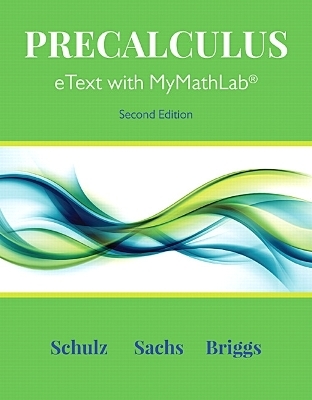
MyLab Math with Pearson eText (up to 24 months) Access Code for Precalculus
Pearson (Hersteller)
978-0-13-475315-7 (ISBN)
- Titel z.Zt. nicht lieferbar
- Versandkostenfrei
- Auch auf Rechnung
- Artikel merken
MyLabTM Math is an online homework, tutorial, and assessment program designed to work with this text to engage students and improve results. Within its structured environment, students practice what they learn, test their understanding, and pursue a personalized study plan that helps them absorb course material and understand difficult concepts. In the new edition, MyLab Math has expanded to include a suite of new videos, Interactive Figures, conceptual questions, graphing calculator support, and more.
The Precalculus, 2nd edition eText by Schulz/Sachs/Briggs/Cochran seamlessly integrates exposition, interactive figures, instructive author videos, and progress checks to immerse students in a rich learning environment. This innovative eText, paired with the author-created videos and print workbook Explorations and Notes, provides a framework for conceptual learning that will lead to success in Precalculus while creating a strong mathematical foundation for calculus.
About our authors Eric Schulz has been teaching mathematics at Walla Walla Community College since 1989 and began his work with Mathematica in 1992. He has an undergraduate degree in mathematics from Seattle Pacific University, and a graduate degree in mathematics from the University of Washington. Eric loves working with students and is passionate about their success. His interest in innovative and effective uses of technology in teaching mathematics has remained strong throughout his career. He is the developer of the Basic Math Assistant, Classroom Assistant, and Writing Assistant palettes that ship in Mathematica worldwide. He is an author on multiple textbooks: Calculus titles with Briggs, Cochran, and Gillett, and a Precalculus title with Sachs and Briggs (where he writes, codes and creates dynamic eTexts combining narrative, videos and interactive figures using Mathematica and CDF technology). Julianne Connell Sachs has undergraduate degrees in Mathematics and Spanish, and a graduate degree in Mathematics from Western Washington University. She taught math and physics in Guatemala for 1 year before joining the faculty at Walla Walla Community College in 2001. Julianne teaches courses ranging from beginning algebra through differential equations at WWCC. Through active learning and the strategic use of technology, she strives to guide students toward a deeper understanding of mathematics. William Briggs was on the mathematics faculty at the University of Colorado - Denver for 23 years, after teaching at the University of California at San Diego and Clarkson University. He received his BA in mathematics from the University of Colorado and his MS and PhD in applied mathematics from Harvard University. He taught undergraduate and graduate courses throughout the mathematics curriculum, with a special interest in mathematical modeling and differential equations as they apply to problems in the biosciences. He has written a series of calculus textbooks and a quantitative reasoning textbook, Using & Understanding Mathematics; an undergraduate problem-solving book, Ants, Bikes, and Clocks; and two tutorial monographs, The Multigrid Tutorial and The DFT: An Owner’s Manual for the Discrete Fourier Transform. He was the Vice President for Education of the Society for Industrial and Applied Mathematics (SIAM), a University of Colorado President’s Teaching Scholar, a recipient of the Outstanding Teacher Award of the Rocky Mountain Section of the Mathematical Association of America (MAA), and the recipient of a Fulbright Fellowship to Ireland.
1. Functions
Introduction to Functions
Graphs
Linear Functions
Combinations of Functions
Transformations of Functions
Families of Functions
Summary and Review Exercises
2. Polynomials and Rational Functions
Quadratic Functions
Polynomial Functions
Real Roots and Factors of Polynomial Functions
Complex Numbers
Complex Roots of Polynomial Functions
Rational Functions
Inequalities
Summary and Review Exercises
3. Exponentials and Logarithms
Exponential Functions
Inverse Functions
Logarithmic Functions
Logarithmic Identities
Solving Exponential and Logarithmic Equations
Summary and Review Exercises
4. Unit Circle Trigonometry
Angles and Their Measures
Unit Circle Definitions of Sine, Cosine, and Tangent
Sine, Cosine, and Tangent Functions
Secant, Cosecant, and Cotangent Functions
Inverse Trigonometric Functions
Summary and Review Exercises
5. Triangle Trigonometry
Right Triangle Trigonometry
Right Triangles and the Unit Circle
Law of Sines
Law of Cosines
Applications of Triangles
Summary and Review Exercises
6. Trigonometric Identities
Fundamental Identities
Sum, Difference, and Double-Angle Identities
Power-Reducing, Half-Angle, and Product-Sum Identities
Solving Trigonometric Equations
Summary and Review Exercises
7. Parametric and Polar Graphs
Parametric Equations
Polar Coordinates
Polar Graphs
Polar Form of Complex Numbers; DeMoivre's Theorem
Summary and Review Exercises
8. Conic Sections
Parabolas
Ellipses and Circles
Hyperbolas
Eccentricity and Polar Equations of Conic Sections
Summary and Review Exercises
9. Vectors
Vectors in Two Dimensions
Vectors in Three Dimensions
Dot Product
Cross Product
Summary and Review Exercises
10. Matrices and Systems of Equations
Systems of Equations and Inequalities
Matrices
Method of Partial Fractions
Summary and Review Exercises
Appendices A: Looking Forward to Calculus: Limits B: Looking Forward to Calculus: Sequences and Series Index Figure Index App. Index
| Erscheint lt. Verlag | 8.1.2018 |
|---|---|
| Sprache | englisch |
| Themenwelt | Mathematik / Informatik ► Mathematik ► Analysis |
| ISBN-10 | 0-13-475315-1 / 0134753151 |
| ISBN-13 | 978-0-13-475315-7 / 9780134753157 |
| Zustand | Neuware |
| Informationen gemäß Produktsicherheitsverordnung (GPSR) | |
| Haben Sie eine Frage zum Produkt? |